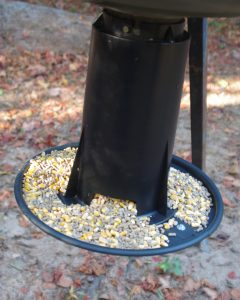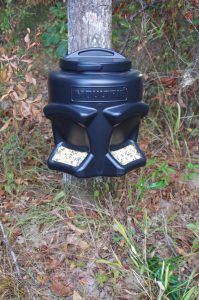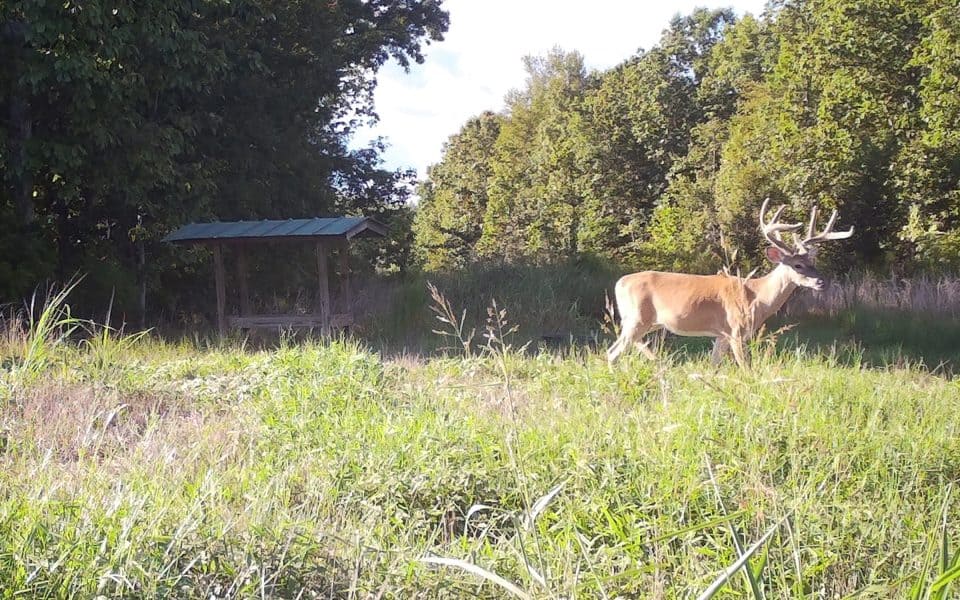Grow bigger bucks! That is the mantra whitetail hunters hear all the time. Every company that profits from the sale of anything related to deer hunting will have you believe their product is the best and that it should be on your shopping list. Be it a supplemental feed or an attractant, the hunter needs to deliver it to the deer on their property in a manner that is convenient for the deer and allows the longest access ability possible.

Deer Attractants
Deer attractants are all those things that are formulated to appeal to a deer’s senses of taste and smell. We’ll narrow that scope to edibles, those things that deer get a “sugar high” after consuming. We’ll break those down later because of the animals need for salt, and the different salt licks on the market that contain various amounts of beneficial trace mineral, some more than others. Attractants, such as yellow corn, have little nutritional value but is cheap to purchase and easy to deliver.
Deer Supplements
Feed supplements are just what the name implies; a dietary supplement that adds to better bones, healthier muscles and greater fat stores. Many of those things that deer get from the soil via the plants they consume. There is little scientific evidence that supplemental feeding on a small scale makes a big difference in deer health and wellbeing, however, if a club or land owner applies their best management practices with food plots and available browse options, supplemental feeding on a continual basis could have some beneficial impact. Such is the case in 2023, when so much of the United States was subjected to prolonged heat and drought that made available browse hard to come by, and less palatable when deer did find it. Deer supplements from Record Rack can pick up the slack for you during these times.
How Should You Feed Your Deer?
 As I alluded to previously, supplemental feeding is often a 12-month endeavor. This is not to say some supplements are not attractants. For the sake of herd management, where camera images are followed for a long period, supplemental feeding allows a game manager to develop a history as to antler growth, movement patterns and overall herd health. Not to mention the number of other critters, such as bobcats, raccoons, and feral pigs that need to be eliminated.
As I alluded to previously, supplemental feeding is often a 12-month endeavor. This is not to say some supplements are not attractants. For the sake of herd management, where camera images are followed for a long period, supplemental feeding allows a game manager to develop a history as to antler growth, movement patterns and overall herd health. Not to mention the number of other critters, such as bobcats, raccoons, and feral pigs that need to be eliminated.
Don’t let your deer herd be out-of-sight, out-of-mind. After hunting season, when winter stresses the herd is when does are recharging after a long time of nursing. With any luck these same does are eating for themselves and their womb full of fawns. This is a stress period when supplemental feeding may be needed. Bucks are coming off the rut, have shed their antlers and are building up to replace those shed antlers. So if your goal is bigger bucks, these formative months are the time to be keeping the best quality food in front of them.
Following the spring green-up, deer will normally wean themselves off of your supplements as lush, tender vegetation becomes available. White-tailed deer require 16 percent protein or better and a wide assortment of trace minerals to function and grow to their full potential. Studies indicate the average deer needs to consume approximately 11 pounds (dry weight) of forage every day.
Types of Deer Feeders
 It’s difficult to say just who takes credit for the mechanized deer feeder. No doubt there is a patent, or several, somewhere deep in the bowels of the patent office. But Moultrie has been a contributor to the proliferation of the mechanized feeder since 1979. Operated by a 6v rechargeable battery, the control panel is smart enough to consider the weight of feed in the hopper (human inputted) monitor the user’s times of spin and pause the motor when the sully of supplement is exhausted, thus saving battery life.
It’s difficult to say just who takes credit for the mechanized deer feeder. No doubt there is a patent, or several, somewhere deep in the bowels of the patent office. But Moultrie has been a contributor to the proliferation of the mechanized feeder since 1979. Operated by a 6v rechargeable battery, the control panel is smart enough to consider the weight of feed in the hopper (human inputted) monitor the user’s times of spin and pause the motor when the sully of supplement is exhausted, thus saving battery life.
Increasingly popular is the gravity feeder, which gives deer a full time feeding station. Many gamekeepers feel a free-choice feeder like this is better than a spin feeder because the deer have access to it whenever they need. Spin-feeders are indiscriminate in their operation, placing food on the ground in all weather conditions where it can be consumed by crows, turkeys, squirrels, raccoons, feral pigs or a whole host of other critters before the browsing deer get there to eat their share.
Moultrie has introduced a new addition to their line of products known as a feeding plate. This converts the spin feeder to a gravity flow for around 50 bucks. Just detach the spin motor mechanism and attach the plate. That’s all there is too it. The spinner can be put back at any time.
 If budget constraints are an issue, a simplistic gravity feeder is easy to build with a 4 to 5-foot section of PVC pipe and a couple of fittings. Place a 45-degree clean-out on the bottom and a cap on the bottom. Save another cap for the top but do not glue it in place. Paint the device to suit your fancy and attach to a tree or to post with bungie cords or ratchet straps.
If budget constraints are an issue, a simplistic gravity feeder is easy to build with a 4 to 5-foot section of PVC pipe and a couple of fittings. Place a 45-degree clean-out on the bottom and a cap on the bottom. Save another cap for the top but do not glue it in place. Paint the device to suit your fancy and attach to a tree or to post with bungie cords or ratchet straps.
Another option is a molded plastic hopper with pre-cut feeding troughs. A removable lid allows for easy refilling. These feeders are excellent for those finer high protein feeds that spin feeders tend to cast to the wind. These feeders work good with all grains and pellets as well as shelled corn.
Is Supplemental Feeding Effective
There are few truly definitive studies available on the effects of year-around supplemental feeding as opposed to natural foraging. A few quasi-studies have been done by those entities which market supplemental food products that always show positive results. That is to be expected when there is profit to be made from the study. This writer happened into an unscientific observation that I will share; which I feel offers some modicum of proof that supplemental feeding on a full time basis offers positive results.
In Scott County Mississippi, a landowner constructed a 900-acre high-fence enclosure, capturing a number of native deer inside when construction was completed. No outside animals were introduced and no artificial insemination has taken place. The genetic footprint of the resident herd has not been altered in any way.
Scarcely one mile away is a Wildlife Management Area owned by the U. S. Forest Service and managed by the Mississippi Department of Wildlife, Fisheries and Parks. It is a still-hunting only, public area. While harvest records are not conclusive, some observations may be made regarding the dietary differences and the effects on genetically similar deer herds.
Inside the high-fence are areas of early sessional growth as a result of best timber management practices, grain crops such as soybeans and clay peas, and food plots with forbs and brassicas. In addition to these foodstuffs, the landowner provides the deer herd with three tons of 18-percant protein pelletized supplements monthly. It is fed through troughs and gravity feeders.
The public land area likewise has early successional growth following timber harvest and food plots managed by the MDWFP. Both areas have data collection with the public area being required but not always observed. The fenced area has 100-percent hunter harvest data.
Anterless deer harvested on both areas show similar weights. In the 100 to 115-pound range. This part of Mississippi is not known for big deer, it never has been. Buck weights however show a distinction between the two areas. In the fenced enclosures buck weight averages 180 to 250-pounds where the public area boasts 155 to 180-pound animals, and occasionally heavier. Age at harvest is not a consideration in these numbers. It is common knowledge that a buck needs to reach 5 to 6 years of age to reach full potential. Something public land bucks rarely do. The oldest recorded deer from the fenced area was 7-years old with a weight of 252 pounds and a score of 156 inches. Public land bucks harvested were 3.5 to 4.5 years old with scores of 140 inches.
In a study conducted at three ranches in Texas it was ascertained that bucks use supplemental feed more than does. Does that used supplemental feed during summer months did not show vast increases in weight where bucks increased at a substantial rate.
Conclusion
Too sum it all up, there is some evidence that supplemental feeding benefits white-tailed deer, but to be certain more controlled studies should be done. Most assuredly many deer in severe weather conditions, areas of higher depravation or habitat loss could benefit. But supplemental feeding is costly, and the return on investment is not clear when a public deer herd is involved.









